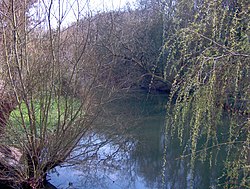| Frome Froom | |
|---|---|
 The river at Snuff Mills | |
 Map of the River Frome and tributaries in Bristol and South Gloucestershire | |
| Etymology | British Celtic, meaning 'fair, fine, brisk’ |
| Nickname(s) | Danny |
| Location | |
| Country | England |
| Region | West Country |
| District | South Gloucestershire, Bristol |
| City | Bristol |
| Physical characteristics | |
| Source | Dodington Park |
| • location | Chipping Sodbury, South Gloucestershire, England |
| • coordinates | 51°30′39″N 2°20′39″W / 51.510726°N 2.344268°W |
| • elevation | 515 ft (157 m) |
| Mouth | Floating Harbour, Bristol |
• location | Bristol, England |
• coordinates | 51°26′56″N 2°35′54″W / 51.4489°N 2.5983°W |
• elevation | 33 ft (10 m) |
| Length | 20 mi (32 km), south west |
| Discharge | |
| • average | 60 cu ft/s (1.7 m3/s) |
| • minimum | 2.3 cu ft/s (0.065 m3/s) |
| • maximum | 2,473 cu ft/s (70.0 m3/s) |
| Basin features | |
| Tributaries | |
| • left | Nibley brook, Folly brook, Fishponds brook (1, Oldbury Court) Fishponds brook (2. Black Rocks), Coombe brook |
| • right | Little Sodbury brook, Horton brook, Ladden brook, Bradley brook, Ham brook (aka Stoke brook), Frenchay brook, Horfield brook (aka Cutlersmills brook) |
| River system | Bristol Avon |
The Frome /ˈfruːm/, historically the Froom, is a river that rises in Dodington Park, South Gloucestershire and flows southwesterly through Bristol to join the river Avon. It is approximately 20 miles (32 km) long, and the mean flow at Frenchay is 60 cubic feet per second (1.7 m3/s). The name Frome is shared with several other rivers in South West England and means 'fair, fine, brisk'. The river is known locally in east Bristol as the Danny.
As with many urban rivers, the Frome has suffered from pollution, but several stretches run through parks and reserves that sustain a range of wildlife. The river's power was harnessed by many watermills, and the river mouth area was developed as shipyards by the eighteenth century. As the city of Bristol developed in the nineteenth and twentieth centuries, flooding became a major problem, remedied by the construction of storm drains and diversions.